Usually people call the human parasite all living organisms at their own expense. These are bacteria, fungi, worms. Human parasites are divided into internal and external. The most annoying and causing the greatest amount of damage to the body is a helminth - a parasitic worm.
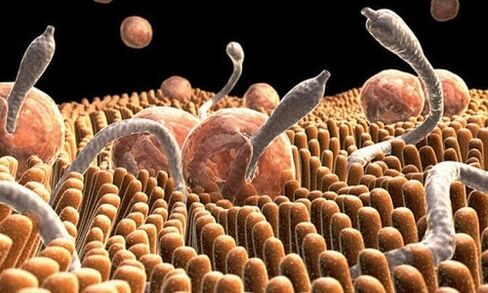
Parasite and human body
The human parasites can be external or internal. The outside includes:
- Mosquito.
- Leeches.
- Cootie.
- Microorganisms that cause scabies.
But there are many organisms that prefer to settle inside the body. Including:
- Bacteria.
- The simplest thing.
- Helminths.
- Mushroom.
The external and internal organization of the parasite is of the simplest type. Due to the fact that they didn't need to evolve to survive, their organization was greatly simplified.
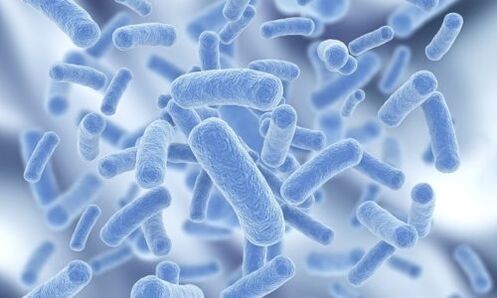
There are many creatures that like to settle inside the body. For example, it could be bacteria.
They cannot survive without a host, as they cannot obtain food on their own. But they all multiply, almost without exception, very quickly, especially under the right conditions. Where they are not immediately directed.
They differ geographically. Some can be found everywhere, any climate is a hindrance to them. Others live only in tropical countries, but on the human body, they can easily carry them to anyone else. In the body, they also settle in different places.
The parasite is suitable for the hollow parts of the body, and the tissues that live in the tissues.
The development cycles of parasites, mainly helminths, are also varied. Some first grow in the ground (biological helminths), and then transition to living organisms. Others need to grow first in the body of any other living organism, but not as a person. Still others in an adult state may be transferred to others or re-infecting themselves.
It is wrong to assume that infection can only happen through dirty hands. The eggs of some helminths are able to stay outside of the nutrient medium for six months and adhere well to animal hair. Eggs also exist in an environment that's dangerous for them - if you cook meat or fish improperly, a swarm of worms can survive inside you.

Meat should not be cooked properly, as worms can form inside you.
Human endogenesis
Parasites are divided into endothelial and extrasymial. Endoparasites - organisms that live inside, ecto - outside. Endoparasites are capable of settling in most internal organs and tissues of the body. They are divided depending on localization. Endoparasites are:
- The endogenesis of internal organs connects to the outside environment.
They settle precisely in organs that are connected to the external environment, not vice versa: the parasite does not choose to "breathe". These organs include the intestines, lungs and the human reproductive-urinary system. These are amoeba, filariasis and parasitic whipworm.
- Parasites in the blood.
They live in human blood. They can live in plasma, white blood cells, and red blood cells. These are trypanosomes, microfilariae or atmospheric heights.
- Endogenous tissue.
Endogenous organisms choose the tissues of the body as their place of residence. Muscle tissue, brain, cartilage, connective tissue. Even in nerve fibers, endothelitis can be deposited. These are Finnish tapeworms, trypanosomes, myxosporidia, trichina and others.
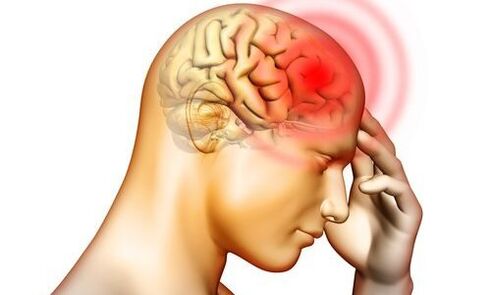
Endoparasites may select the brain as the residence.
The definition of a parasite according to its place of residence is quite arbitrary. Many species can migrate through different internal organs and frequently move in the host's body. Reproduction can take place in one place, and organisms will directly exist and feed elsewhere. Where the parasite resides and will be considered its conditional habitat.
Despite the simplification of many parasitic systems, their life cycle is quite complex.
Some species, during their lifetime, have to change hosts, possibly from different biological species. Others may exist in only one species, but they may require an intermediate host. In one person, they reproduce, and in another they develop and mature. With such a complex life cycle, their sexual functions are greatly increased. In order to survive in the body, the parasite must multiply rapidly and greatly.
Helminths
There are three main types of helminths, also known as filariasis. It:
- Nematodes, they are roundworms.
- Parasites, ice-shaped parasites.
- Flukes are also known as trematodes.

Geohelminths began to exist in the earth of the earth.
Furthermore, they can be divided over time of their life cycle and the number of places they pass along the way. There are also three types:
Geohelminths
"Geo" is the earth. These worms begin to exist in the ground, only after adulthood can they infect humans. They do not need an intermediate host; The eggs enter the soil with human feces. Until the larval stage, they develop exclusively in the warm season.
Such worms include roundworm, intestinal eel, nekator, whipworm.
The larvae of these parasites can enter the human body through unwashed vegetables or in direct contact with the soil.
Biological worms
These are parasitic worms whose life stages pass through a number of hosts. There may be two or more intermediate hosts, depending on the worm type. Some parasites change only one person. Others, before finally entering the human body, use organisms of other biological organisms to thrive.

You can get it through pets or by contact with other people, as well as by eating half-raw meat. Tapeworms include bovine tapeworms, tapeworms, tapeworms, helminths, and others.
Worms are contagious
These worms need neither soil nor an intermediate host. They go through all the stages of the life cycle in an organism, in a very comfortable position. The larvae are eliminated directly from the human body, when they come into contact with surfaces in the house and other people, they spread freely.
The helminth can live in different organs and systems of the human body, periodically migrating from one part of the body to another.
The list of diseases caused by helminths is very rich. It is possible to identify which parasites live in the body and can only initiate treatment after all the tests necessary to establish this type of test have been passed.
Nematodes
The most common in human habitat is roundworm, also known as nematode. In total, there are more than 24 thousand species of nematodes in the world.
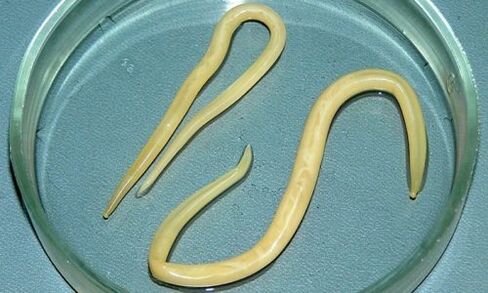
The most common species of nematodes in humans are roundworms.
They are called round because of their shape, which will show up if you cut them across. The most common types of nematodes in humans:
- Roundworm.
- Pinworm.
- Trichina.
- Vlasoglava.
Cysticercosis, known as roundworm disease, begins with direct contact with earthworm-infested soil or by eating unwashed fruits and vegetables. The parasite begins to develop in the intestines, then enters the human circulatory system, from where they travel to various internal organs, to the oral cavity. One person, not realizing this, has swallowed up an adult parasite. They eat the remains of undigested food. The waste products from the roundworm are extremely toxic. There is no vaccine for ringworm; infection can only be prevented by observing the rules of personal hygiene.
Pinworm infection is called intestinal helminthiasis. These are small worms (5-10 mm) that attach to the intestinal wall. They eat blood and substances contained in the intestines. They lay eggs under the skin, going out of the anus when the owner sleeps. Due to the itch, the sick person scratches the anal area, the larvae will crawl into the skin and on their hands, and can be easily transmitted to others in the home or public place. Pinworm infection has no painful symptoms; Detecting pinworm infection at an early stage is extremely difficult.
Trichinella, they are also Trichina, are roundworms that choose an animal or a person as their owner.

Trichinella is a parasitic worm, which enters the human body, causing dangerous trichinosis.
They begin to develop in the striated muscles of the body, and then they are diverted to the small intestine. In severe infections, there can be as many as 15, 000 Trichina eggs per kg of muscle tissue. These parasites are capable of causing a deadly disease, named after its origin - helminthiasis.
Whip worms are so named because of their appearance. The anterior part of their small body is thread-like, with an esophagus in it.
The broader posterior part, the rest of the parasitic's internal organs are located in it. Whip worms can be up to 50 mm long. It eats blood and tissue fluids. Worm disease causes the disease.
Tapeworm
There are about 500 known species of tapeworms around the world, also known as tapeworms. These flat worms have absolutely no digestive system, and the diseases they cause are called filariasis.
The most common species of cestodoses:
Lymphatic fluke disease
The disease is caused by the larvae of the pig tapeworm that get inside through contaminated food, from dirty hands.
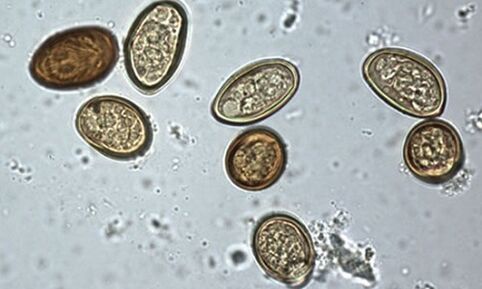
The disease affects the skin, bones, internal organs, brain and spinal cord. Usually, the parasite is sent to the brain (in 60% of infections). It is diagnosed based on the appearance of round shapes on the skin. The disease is treated, in the case of infection of the central nervous system, the prognosis may be unfavorable.
Echinococcosis
It is localized in the liver, lungs and many other internal organs. The larvae of Echinococcus provoke disease. They can grow inside of a person for several years.
Infection occurs by contact with animals, picking berries, drinking contaminated water.
The course of the disease is not so noticeable, it can develop over the years and is discovered by accident.
Alveococcosis
Pneumococcal disease is caused by the larvae of the pneumococcal worms. The disease is similar to echinococcosis, but is more severe. Affects the lungs and kidneys. If left untreated, the disease has a high probability of death due to progression to liver failure.

Alveolar disease often affects the kidneys.
Teniarinhoz
Teniarinhoz is caused by a type of bovine tapeworm. It parasites tapeworms in the area of the human small intestine, developing in a period of 2, 5-4 months. The prognosis of treatment is usually favorable. The parasite can enter the human body with contaminated raw meat or underprocessed heat.
Tapeworms are highly fertile. They have the lowest sensitivity remaining and have no digestive system at all. Such parasites cannot develop without a host.
Fluke worms
Flukes are flukes. These are flattened worms whose body shape resembles an elongated leaf of a tree.
Some species of trematodes can be up to a meter and a half in size.
And they usually enter the human body through fish or other seafood. About 7. 200 species of fluke are known, 40 of which live in humans and cause trematodes, a serious disease caused by infection.
The most common types of flukes:
Liver fluke
Distributed globally, can exist in animals and humans. The life cycle is complex, the parasite changes its host.
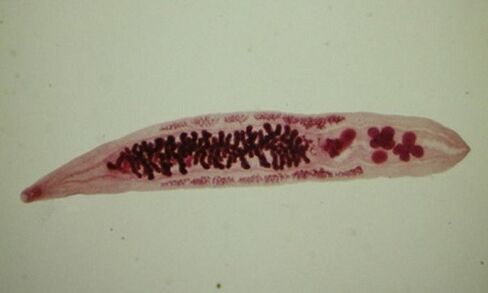
The most common type of fluke is the liver fluke.
Schistosoma
Schistosome larvae can penetrate the skin or mucous membranes. The life cycle is very complicated, they eat blood. A female is capable of laying about 3000 eggs per day, the fertility of these parasitic worms is very high.
Other types of liver fluke
They cause opisthorchiasis, a helminthiasis that spreads primarily in the liver. They have a toxic effect on the human body.
The worm's digestive system is well developed, along with the reproductive and excretory system.
The rest of the systems are poorly developed. The flukes feed on the blood, epithelial cells of the skin and the contents of the intestine. They can live almost anywhere: from the liver to the conjunctival sac of the eye.
Other types of endoparasites
The rest of the internal parasites are many types of bacteria that cause dangerous diseases, and with them the simplest microorganisms. The fungus that spreads inside the human body also belongs to the parasite.
Many beneficial and harmful microorganisms live in the human body. Some of them cause quite dangerous illnesses that can lead to death. It is not always possible to immediately recognize the presence of parasites inside you, but early diagnosis of infection will have a chance of a complete cure. If you suspect an invasion, you should quickly get a full examination by your doctor.



































